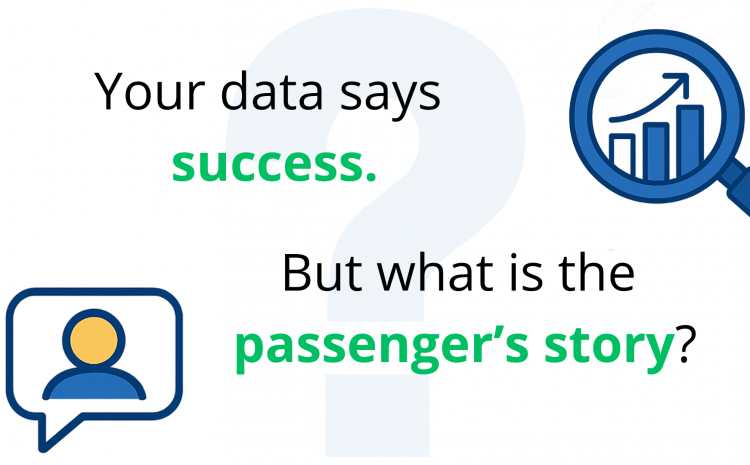
The Gap in Aviation Assisted Service You Can’t Afford to Ignore
On paper, an aviation assisted passenger service operation can appear to run like clockwork.
Agents are assigned in seconds. Teams meet their on-time targets. Monthly KPIs remain comfortably in the green.
But speak to a passenger who has just completed their journey, and the story often sounds very different.
The gap between what the data shows and what passengers actually experience is one of the most overlooked risks in assisted service delivery. It is not only a matter of perception, but of trust, reputation, and long-term compliance resilience.
The Data Records Milestones. Passengers Remember Moments.
Most assistance systems log a familiar set of events:
- “Passenger met”
- “Agent arrived at gate”
- “Passenger boarding completed”
While these entries confirm that tasks were completed, they reveal nothing about how the journey felt.
From a dispatcher’s perspective, the service was delivered on time.
From a passenger’s perspective, they may have waited 25 minutes in silence, unsure if help was actually coming. Their assistant may not have spoken their language. Upon arrival at the gate, they might have been left without instructions or reassurance.
Same journey, two realities.
Systems capture tasks, while the passenger lives the experience.
The Invisible Gaps
Many assisted service breakdowns are not seen in the systems used by operators, but passengers notice them immediately:
- Meeting points that are unclear create uncertainty before the journey even begins.
- Long stretches of silence erode trust.
- Language barriers caused by inadequate matching between passenger needs and agent capabilities can leave passengers feeling isolated.
- Lack of guidance at the gate turns the final minutes into the most stressful part of the trip.
While these might seem like small inconveniences or even remain invisible to the operations, they are actually defining moments that shape how an airline, airport, or service provider is remembered.
Why the Numbers Don’t Tell the Whole Story
Operational systems are designed to measure completion, not connection.
Operation managers rarely follow the full assistance journey from a passenger’s point of view, and reporting tends to focus on whether the job was done, not how it was experienced.
Strong KPIs can mask significant experience gaps until they are revealed by a complaint or a public review.
Why This Matters
A journey that feels disconnected can quietly damage an operation’s reputation and performance:
- A single poor experience can spread rapidly through social media or news outlets.
- Regulators are placing greater emphasis on qualitative service measures, including dignity and care.
- Passenger trust is built (or broken) in moments of vulnerability.
- Experience quality is increasingly a deciding factor in tenders and audits.
Ozion Manages the Direct Line to the Passenger Perspective
This is where Passenger Companion™ changes the picture.
Through the direct to passenger interface, passengers are supported throughout their journey, providing timely updates and reassurance at each stage. This ongoing interaction reduces anxiety, builds confidence, and helps passengers feel cared for from start to finish.
At the very end of the journey, when the passenger is no longer with the service agent, they are invited to share how the assistance felt. Because feedback is collected privately, away from the eye of the agent, the passenger can respond openly without outside influence.
There are no logins and no long forms. Just one simple question: “How was your assistance today?”
With a single tap, the passenger chooses a smiley face that reflects their mood. If they wish, they can add a comment in their own words, such as “My agent was so kind and reassuring” or they can let the operation know if they had a different kind of experience.
The result is feedback that is quick, accessible, and genuine, and it is already being adopted at scale. More than 30 percent of assisted passengers are using Passenger Companion™ when given the option, with 15 percent providing post-journey feedback, offering an effortless, authentic, direct-from-passenger perspective that traditional surveys, KPIs, and formal complaints can never capture.
The usage is far and above any other passenger interface, outpacing apps three to four fold. Interesting to note, the PRM Manager can also integrate airline and third party apps to gain this additional advantage for the service operations and the passenger experience.
Turning Passenger Feedback into Action
Because the Passenger Companion™ is fully integrated with Ozion’s PRM Manager, each response is automatically linked to the exact service event it relates to. This enables teams to:
- Monitor passenger sentiment in real time.
- Identify recurring service gaps before they escalate.
- Recognize and celebrate outstanding assistance using genuine passenger feedback.
The result is continuous, contextual insight delivered without adding workload for frontline, operational, or managerial staff, and with complete transparency for leadership.
From Milestones to Meaningful Moments
Milestones confirm that a service was delivered. Passenger Companion™ reveals how it was experienced, closing the gap between operational success and the human moments that define trust.
What Could Passenger Companion™ Reveal About Your Service?
Discover how Ozion’s PRM Manager, including Passenger Companion™, can transform your assisted passenger operations. Click here for more details, or fill out the form below for your personalized walkthrough.


